Historical review – Collaboration with the University of Crete64
8.3.1 Introduction
In an island like Crete, which also lies as a “golden-green leaf thrown into the sea” of the Eastern Mediterranean, marine biology could not be absent. Distinguished professors Fotis Kafatos (Harvard University) 65 and Vassilis Nafpaktitis (University of Southern California) could not ignore this need when in the early 1980s they were invited by the University of and organize the Biology Department. The two professors, one of the pioneers of the founding of the University of Crete, really founded the Department of Biology on a solid basis and supported its development taking into account emerging scientific fields, such as molecular biology and biotechnology, but also marine biology. The first nucleus of human resources, which undertook to serve the purpose of the development of marine biology at the University of Crete were, apart from V. Nafpaktitis, professors who were invited mainly from abroad, such as Eleft. Zouros, Anast. Eleftheriou, Nik. Tsimenidis and, a little later, Maroudio Kentouri.
The Department of Biology, by a conscious choice of its founders, began the historical course of its educational activities in 1983 following a model of a research university. Thus he developed his postgraduate studies (and in fact, at the doctoral level, since at that time there was still no law in Greece).
Special Framework for Postgraduate Programs (AD cycle), without having yet hired undergraduate students, while the members of the Teaching and Research Staff focused heavily on their programs.
8.3.2 Historical retrospect
In the mid-1980s one of the first (if not the first) doctoral programs in Greece was established, which also included the direction of environmental biology (a direction that later became the Matrix from which the program marine biological resources”). This program attracted pan-Hellenic interest and students were selected to attend it after intense
————–
64 The writing of this text would not have been possible without the substantial participation of the director of ITHABVYK – HCMR Antonis Magoulas, who provided a relevant informative text and to whom I thank very much.
65 Especially for Fotis Kafatos, Lefteris Oikoniou in a special interview he gave to the author of this volume, will state: “Especially for Fotis Kafatos, I must say that
he was actually a famous man. He was the first to isolate a gene in the history of humanity. “
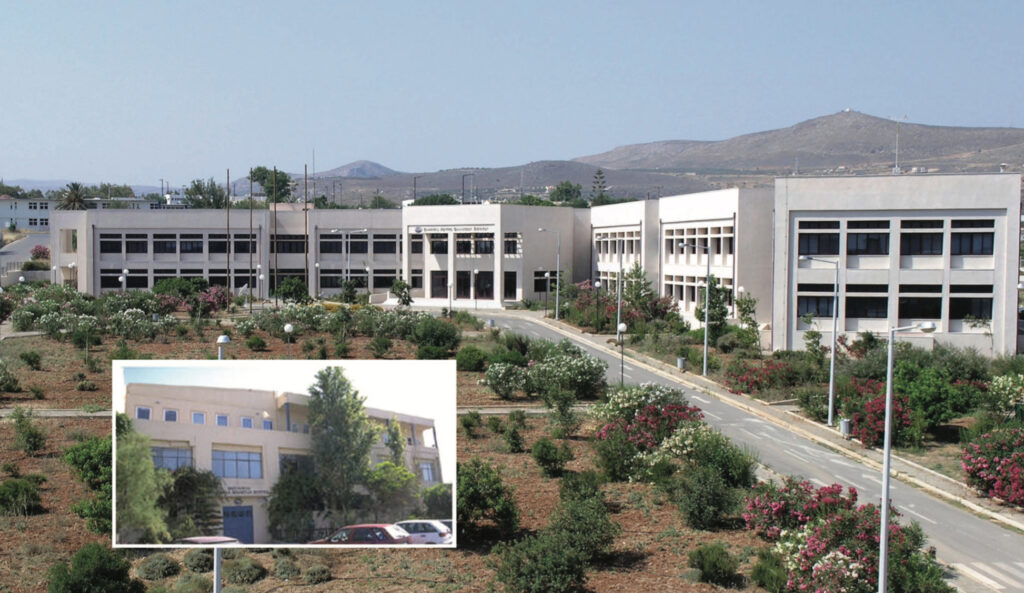
The old building of IMBBC in the port of Heraklion, and the current main building of HCMR in the complex “Thalassokosmos”.
competitive examinations. These students, having the sense of participation in an unprecedented and extremely promising experience in the Greek educational system, were enthusiastic about their studies in Crete. The professors of the Department of Biology took advantage of the existence of this program and, with the contribution of the postgraduate students who conducted their studies under their supervision, exercised the task of promoting the educational and research process in a spirit and spirit of merit. The research projects that were won, mainly through external competitive financing, operated within the framework of the then EKEK (Research Center of Crete), while their experimental activities were hosted in the buildings and laboratories of the Department of Biology, located in the prefabricated buildings of Heraklion.
The first substantial step towards consolidating the marine biology research direction was the successful launch of NATO’s Science for Stability program, which aimed to explore the Greek seas and “polarize” the effort significantly. The next important milestone was the shipbuilding in Piraeus, in 1985, and the delivery to use a year later of the research vessel “PHILIA”, with funding from the General Secretariat for Research and Technology (GSRT). The great advantage of “PHILIA”, a 26-meter-long boat, was its flexibility, since due to its special construction it is large enough to travel on the high seas, but it can also sail very close to the shore due to the shallow keel. of. In 1997 FILIA was equipped with a bow bulb and a second one engine, in the context of the decision of the Greek state to strengthen marine research. Its base was located in the port of Heraklion and in the 30 years of its existence it has carried out thousands of Research Voyages in the Aegean and the Ionian Sea, as part of missions for environmental, fishery, biological, ecological and oceanοgraphic studies.
Following these developments, the conditions were ripe for the establishment of an institute dedicated to the development and promotion of marine research in Crete, based on the unprecedented possibilities offered by international scientific and technological developments. In addition to the high technological developments, the conditions created locally were extremely favorable due to the existence of a high level of human resources and infrastructure. Indeed, in 1987 the Institute of Marine Biology of Crete (IMBBC) was founded. The relevant P.O. defines: “An independent Research Institute is established under the name Institute of Marine Biology of Crete (IMBBC). This Institute is a legal entity of private law or non-profit character and is based in Heraklion, Crete. More specifically, based on the founding P.O. It is defined that: “IMBBC is supervised by the Minister of Industry, Energy and Technology. The supervision exercised over IMBBC by the YBET includes financial and managerial control, as well as administrative control over the legality of the acts and actions of its administrative bodies “.67
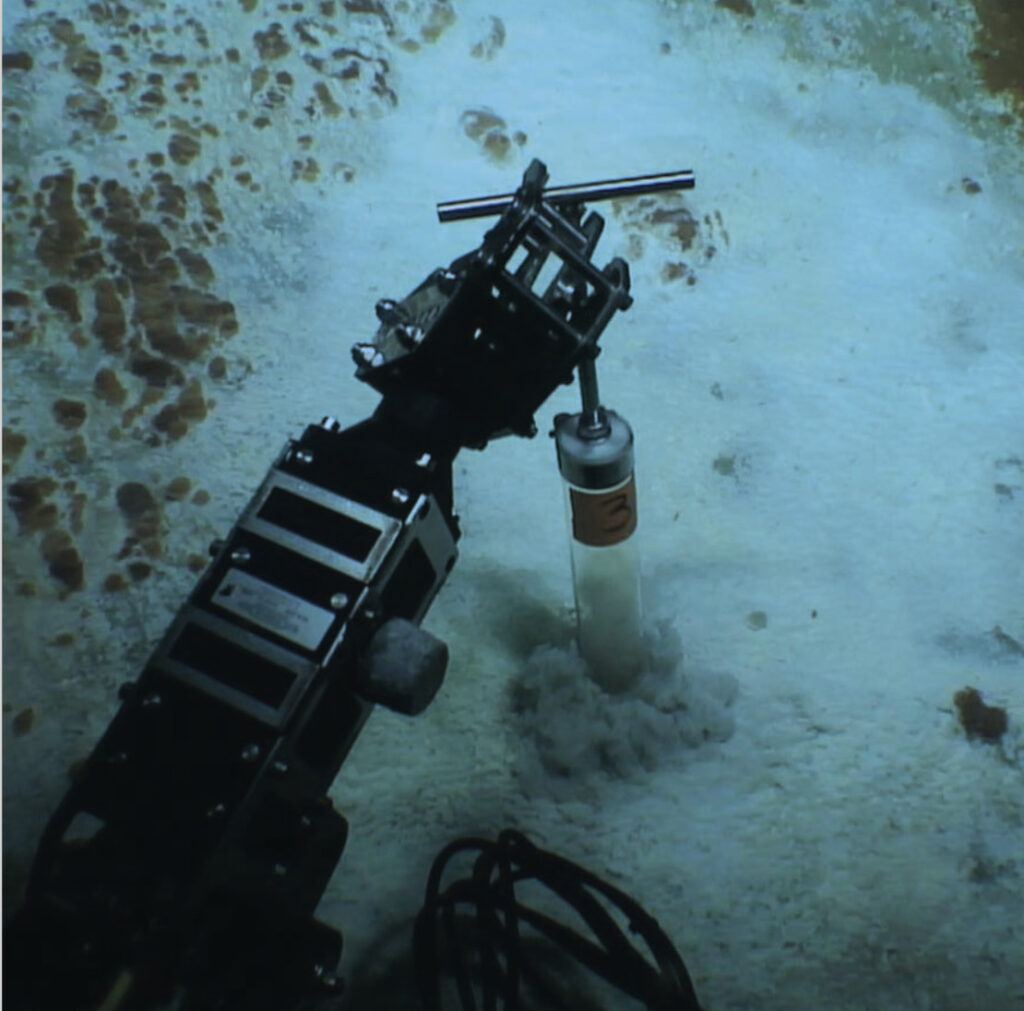
Submarine sampling using a remote control (ROV) submarine for boundary microbial analyzes.
——————————-
66 PD 331, Government Gazette 152 / 27-08-1987, vol. A., article 1o. Establishment – Headquarters.
67 PD 331, Government Gazette 152 / 27-08-1987, vol. A., article 2o.
68 PD 331, Government Gazette 152 / 27-08-1987, vol. A., article 3. Purpose.
IMBBC remains closely connected with the Department of Biology of the University of Crete and its purpose is reflected in the founding PD: “Purpose of IMBC is the development of scientific and technological research and the promotion of applications in the field of Marine Biology, for the development of know-how in marine biology and related scientific fields “.68
IMBC was to prove to be a very successful operation, which in the following years gained international recognition, but also the love and active support of the local community. Professor of the University of Crete, Tasos Eleftheriou, was elected as the first director of IMBC, who with an open spirit and tireless efforts sought and achieved the development and consolidation of his institute in the national and international scientific scene. In the administration of the institute there was also a scientific council, of which the professors of the University of Crete, V. Nafpaktitis, L. Zouros, N. Tsimenidis and M. Kentouri were members.
Over the course of a decade, IMBC was at the forefront of research in marine biology at national, European and international level. A small part (less than 10%) of its budget was covered by direct national funding (regular budget), while most of it was obtained through competitive European and national funding, services to public sector and the industry (mainly aquaculture companies), and product sales.
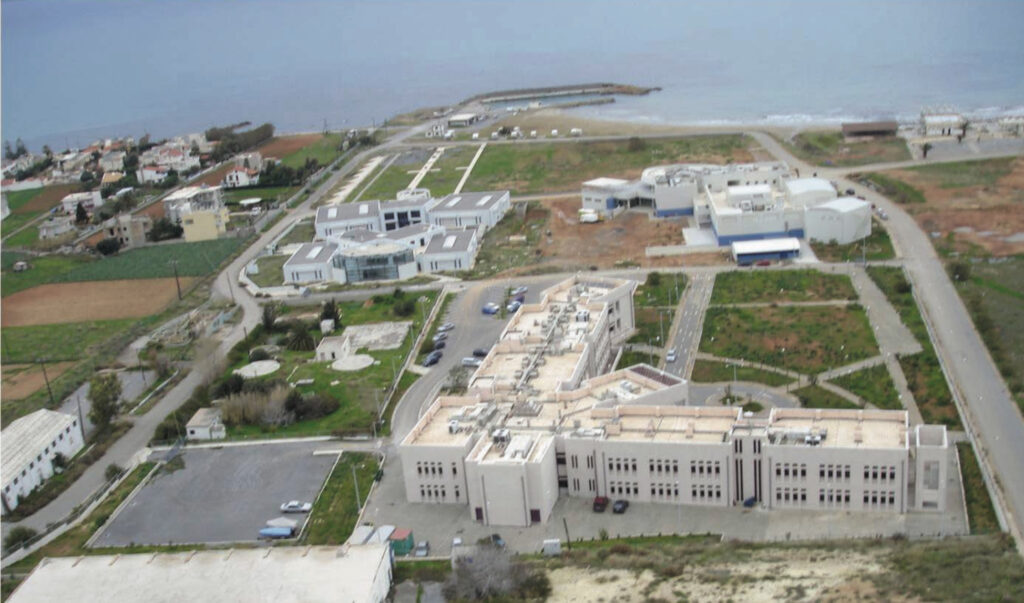
Aerial view of the composer- At the former US base in Gournes.
8.3.4 The further course
As the Institute gained critical mass in terms of staff, the following research topics were developed:
• Department of Fisheries Biology
• Department of Aquaculture
• Department of Marine Ecology and Biodiversity,
• Department of Oceanography
• Department of Technology and Marine Environment Management,
• Department of Hydroacoustics and Marine Information Systems
• Department of Genetics and Molecular Biotechnology
In 1995, the election and hiring of the first researchers at IMBBC marked the final step in the direction of the development of the Institute based on the organizational structure provided by its statutory provisions. Pascal Divanach was then elected Director of Research (First Grade Researcher) and Antonis Magoulas, Tasos Tselepidis, Argyris Kallianiotis and Costas Dounas as Principal Investigators (Second Grade Researchers). It is characteristic that the first three of the four selected B-level researchers had obtained their PhD from the Department of Biology of the University of Crete, in the field of environmental biology.
P. Divanach, A. Magoulas and K. Dounas were in Ithe first three-member “official” scientific council of IMBBC, which later became four-member with the addition of T. Tselepidis.
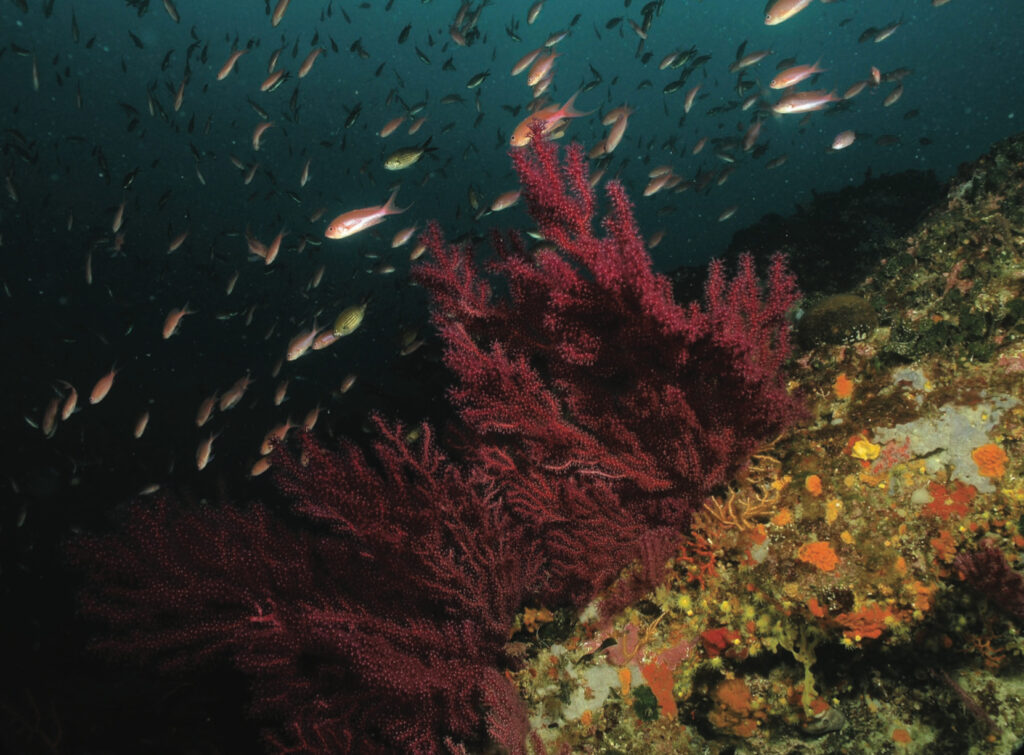
Colorful biodiversity of the Greek seas (© Thanos Dailianis)
In 1998, Lefteris Zouros, a Professor at the University of Crete (and at Dalhousie University in Canada), succeeded Professor Tasos Eleftheriou as director of the Institute. During his tenure he managed to continue the development course of IMBBC, while with successful moves he promoted crucial steps for the course of the Institute.
In 1999 IMBC acquired the submarine remote control vehicle (ROV) “MAX ROVER”. It is a vehicle which can attempt diving up to a depth of 2000 meters and which is operated by the research vessel through fiber optic cable. The first test of the MAX ROVER took place at sea between Crete and Thera, at a depth of 1854 meters. Since then, it has proven to be a valuable tool not only for scientific missions, but also in cases of lifting materials and items from shipwrecks (e.g. “dark boxes”) in case of accidents.
A decisive event for the development of IMBC was the construction of large modern facilities of the Institute on the site of the first American base in Gournes, Heraklion. The result was the creation of a unique for Greece complex of research, education, tourism and entertainment, known as “Thalassokosmos”. The creation of Thalassokosmos, which took place in September 2001, was a combination of national (EPET II) and European (EU and EFTA funding) resources.

The complex was developed in an area of 58 acres and includes:
• The main building with research laboratories, administrative services, conference rooms, library, etc., with a budget of 1.85 billion drachmas and a total area of about 5,500 sq.m.
• The two aquaculture buildings (Aqualabs) with laboratories and facilities for fish farming and supporting structures, with a budget of 440 million drachmas and a total area of about 3,500 sq.m.
• The Aquarium of Crete (Cretaquarium), the largest aquarium in the eastern Mediterranean, with a budget of 2.56 billion drachmas and a total area of about 4,100 sq.m.
8.3.5 The Aquarium of Crete
In December 2002, the Aquarium of Crete was established, which opened its gates to the public in October 2005. It started its operation with 23 tank visits, but later another 25 were added, presenting various Mediterranean ecosystems and useful low-energy cost water purification (filtration) systems, developed by the Aquarium staff. Today the Aquarium has a total of 60 tanks in size ranging from 25 liters to 900 cubic meters. Thousands of marine organisms are hosted and exhibited in environments that mimic natural habitats, such as those in Matala and Vai. The Aquarium of Crete focuses its interest mainly on the presentation of Mediterranean marine life, but also includes alien species, with a special emphasis on the Lessepsian migrants, 69 as well as some tropical species. In the early stages of its operation and because it was the first aquarium of this size in Greece, a special research effort was required for the acclimatization of animals in captivity, such as jellyfish and sharks, for which there was no relevant experience in Greece.
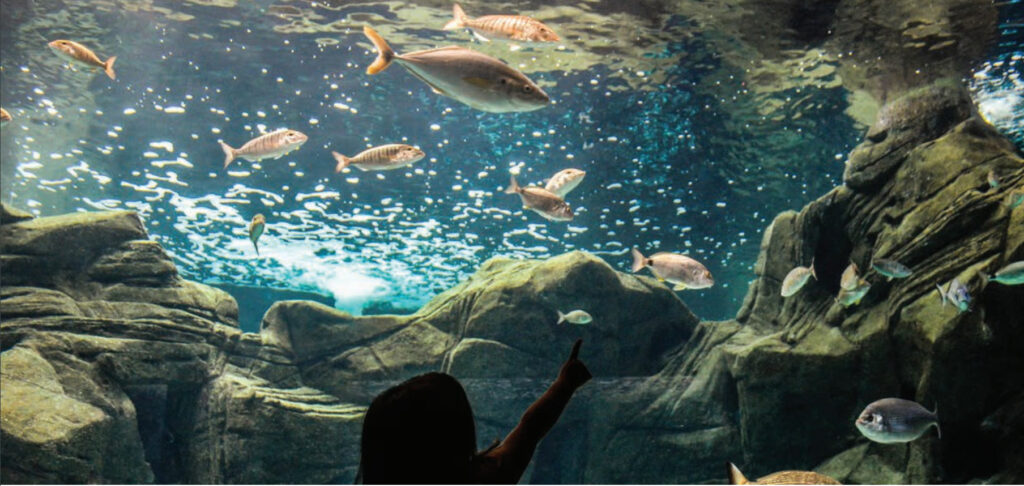
The initial choice was for the Aquarium to acquire, in addition to its exhibition character, which gave a new high-quality dimension to local and national tourism, an important role in the promotion and dissemination of information produced in the research institutes of IMBC initially and Hellenic Center for Marine Research (HCMR) later. It has the significant advantage of operating in close cooperation and being supported by the Center’s research teams, especially those in the aquaculture sector. Thus, it is an aquarium that combines an exhibition, educational and research role. It has won not only the appreciation, but also the love of the local community, being now one of the main poles of attraction for the tourism and culture of Crete.
——————————-
69 This is a term denoting the species of fish and other marine organisms of tropical origin which entered and settled in the Mediterranean from the Red Sea after the opening of the Suez Canal in 1869. They were so named after the French diplomat – engineer Ferdinand de Lesseps, who pioneered the opening of the canal. The settlement of Lessepsian migrants in the Mediterranean is generally considered to be a threat to the ecological balance and quality of the Mediterranean marine environment. The most famous example of a Lessepsian migrant is the “hare” fish.
—————————
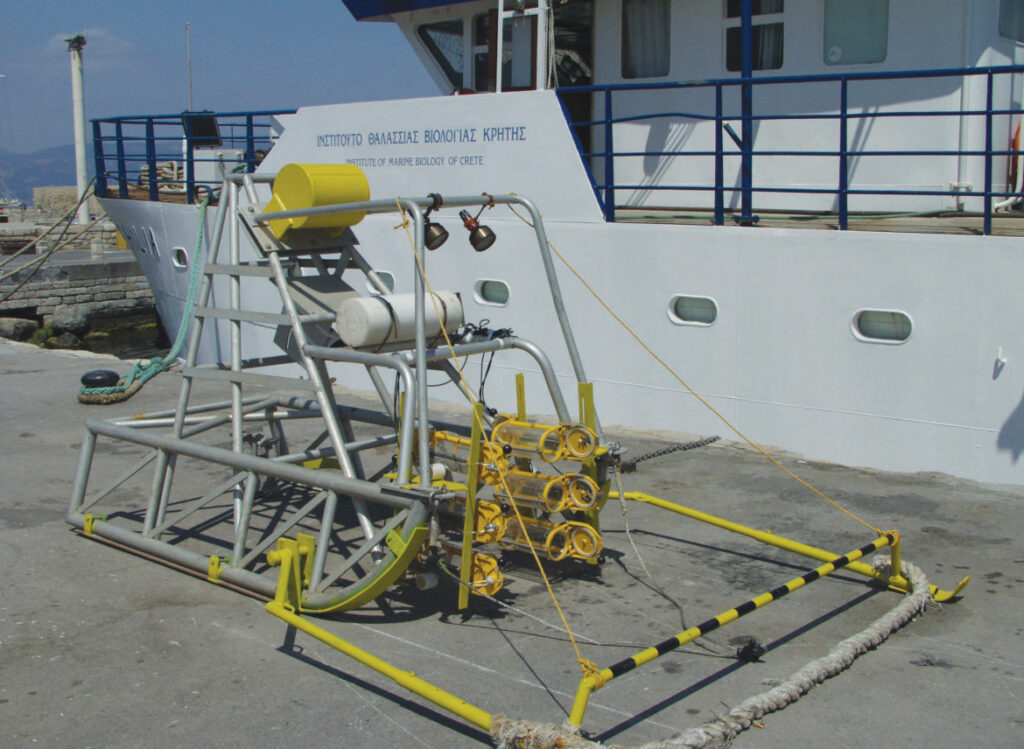
8.3.6 Mergers and developments
In 2001, a law was published, according to which “A legal entity under public law was established under the name Hellenic Center for Marine Research (HCMR). The National Center for Marine Research (NCMR) and the Institute of Marine Biology of Crete (IMBC) were integrated and incorporated in the HCMR. Presidential decrees (PD), issued on the proposal of the Minister of Development, regulate the issues of organization and operation of the Hellenic Chamber of Commerce and Industry, as referred to in the provisions of paragraphs 1 and 2 of article 25 of law 1514/1985.”70 More simply, this law following a trend that prevailed in Greece at the time (and not only) for the creation of large-scale research bodies, envisaged the merger of IMBC with the NCMR in a wider research center under the name Hellenic Center for Marine Research (HCMR). It was a legal person under public law based in Athens. The HCMR actually started operating two years later, in 2003.
The HCMR consisted of five institutes:
• Institute of Oceanography (IO),
• Institute of Marine Biological Resources (IMBR),
• Institute of Inland Water (IIW),
Institute of Aquaculture (IA) and
• Institute of Marine Biology and Genetics (IMBG).
The last two Institutes (IA and IMBG), based in Crete, included the majority of IMBC staff. The first directors
——————————–
70 Law no. 2919/128 / 25-6-2001 “Connection of research and technology with production and other provisions”.
———————————-
who were elected to these two Institutes were researchers from IMBC (Pascal Divanach and Antonis Magoulas, respectively). Certain research groups of IMBC joined, based on their subject matter, the two institutes (IO and IMBR) based in Athens, thus forming the “branch” of Crete in them.
In 2012 a new law and new mergers followed.71 In Article 5 of this law the term “mergers of research bodies” is defined as follows:
a) “The Institute of Inland Waters and the Institute of Marine Biological Resources of the “Hellenic Center for Marine Research” (HCMR) established under par. 3 of article 10 of law 2912/2001 (Α΄ 128), are merged into a new Institute called the “Institute of Marine Biological Resources and Inland Waters” .72
b) “The Institute of Marine Biology and Genetics and the Institute of Aquaculture of HCMR are merged into an Institute called the Institute of Marine Biology, Biotechnology and Aquaculture”.
c) “The Hellenic Center for Marine Research consists of the following institutes:
i) Institute of Oceanography,
ii) Institute of Marine Biological Resources and Inland Water and
iii) Institute of Marine Biology, Biotechnology and Aquaculture”.74
A second round of mergers of the research institutes at HCMR was therefore completed, during which the two Institutes based in Crete were merged to form the now-existing “ (IMBBC)”, director of which was elected Dr. Antonis Magoulas.
8.3.7 General valuation
Evaluating the history of IMBC and its successors, one can see that it was a body that started from a small number of professors and another also small nucleus of people, directly connected to the University of Crete. This research Institute followed an extremely successful course, as a result of which it revived the marine biology in Greece, conquered a leading position in the Mediterranean area and a very distinguished place in the European and international space. In addition to its main objective, namely the progress of basic and applied marine research, IMBC also consciously served the goal of prudent use of Eastern Mediterranean resources by all countries that share this unique for the human history sea area. To achieve its goals, the Institute has developed close cooperation and joint actions with the most important research organizations in Europe, as well as with numerous other agencies, national and international. He also collaborated closely with
——————-
71 Law 4051, Government Gazette 40 / 29-2-2012, “Pension content regulations and other urgent regulations for the implementation of the Conciliation Memorandum of Law 4046/2012.
72 Ibid., Article 5 par. 5a.
73 Ibid., Article 5 par. 5c.
74 Ibid., Article 5 par. 5c.
all the academic and research institutions of Crete (University of Crete, including the Museum of Natural History of Crete, FORTH, Technological Educational Institute
of Crete, ELGO “Dimitra”, Technical University of Crete, MAICH of Chania, as well as with the local authorities (municipalities and the Region of Crete).
Among the main scientific achievements of IMBC are:
• Its crucial contribution to the explosive development of the aquaculture sector in Greece. This development is one of the best examples the country has of linking research with production and of utilizing research results in industry. It is no coincidence that the development of aquaculture in Greece, which is now one of the main export sectors of the country, started almost from scratch in the mid-1980s, the same period that IMBC was founded and followed by a parallel development course with it.
• The introduction of modern disciplines and technologies, such as molecular approaches, for the study of natural and farmed populations. The use of genetic markers in marine biology studies was introduced for the first time in Greece at IMBC. These studies have been extended in recent years to the microbial world with very significant prospects for biotechnological applications.
• The promotion of the study of extreme marine environments and ecosystems (e.g. deep sea, underwater hydrothermal vents) thanks to the acquisition of the appropriate advanced equipment first (e.g. ROV) and the development of relevant expertise thereafter.
8.3.8 University of Crete and IMBC: A reciprocal relationship
In conclusion, for the establishment of IMBC, professors of the Biology Department of the University of Crete led the way, while in the following 30 years there was a parallel course of the two institutions in close cooperation,
complementary actions and mutual feed. It is characteristic that the first two directors of IMBC (A. Eleftheriou and E. Zouros) were professors of the Department of Biology, while the current director of IMBBC (A. Magoulas), as well as 12 researchers of HCMR have obtained their PhD in the Departent of Biology of the University of Crete. In the same way, from the professors currently serving in the Department of Biology, the former and current vice-rectors of the University of Crete M. Kentouri and I. Karakasis respectively, the president of the Department M. Pavlidis, as well as two other members of the Department of its teaching staff (G. Koumoundouros, M. Ladoukakis), have been appointed in various capacities (postgraduate and / or doctoral studies, collaborating researchers, etc.) at IMBC.
The cooperation of the two bodies concerned issues of education and training at undergraduate and, mainly, postgraduate level, as well as competitive, high-quality research. Professors of the University of Crete and researchers of IMBC and HCMR collaborated for the teaching, as well as the supervision of diploma theses and dissertations of MSc and PhD diplomas. The high-level laboratory facilities and equipment of both institutions were at the disposal of the students for the execution of the experimental part of their work. The result of this collaboration was the attraction of first-class academic and research staff in Heraklion, the development of a unique research environment for marine biology and the creation of excellent facilities and a high level of infrastructure.
Today in the field of education the long-term cooperation of the two bodies in the framework of the postgraduate program “Environmental Biology: management of terrestrial and marine biological resources” is still strong, while the cooperation within the framework of the international program “Erasmus Mundus Joint Master Degree in AquaCulture, Environment and Society” (EM JMD ACES), has recently been added, in which the Department of Biology of the University of Crete is one of the main partners and HCMR is an affiliated partner.
Finally, in the field of research cooperation, the participation of IMBBC – HCMR and the Biology Department of the University of Crete in the national infrastructure “Center for the Study and Sustainable Exploitation of Marine Biodiversity (CMBR)” is important. In this Infrastructure, which is included in the national road map of the research infrastructures, IMBBC – HCMR has the coordinating role and the Department of Biology is the main partner. The operation of this infrastructure is expected to give new impetus and potential to the cooperation between the Department of Biology of the University of Crete and HCMR, but also to upgrade the role of marine research for the scientific and economic development of the country.
Chapter 8.1 from the Book “University of Crete: the Genesis and the Course”, Ioannis Pyrgiotakis, Rectorate of the University of Crete and I.E. Pyrgiotakis, 2018 (in Greek). This chapter was prepared in Greek and translated in English by Dr. Antonios Magoulas, former IMBBC director.
Δεξιά ο καθηγητής Νίκος Τσιμενίδης και αριστερά, πίσω από τον Τσεχοσλοβάκο αντιπρόεδρο, ο τότε διδακτορικός φοιτητής και νυν διευθυντής του ΕΛΚΕΘΕ Αντώνης Μαγουλάς






